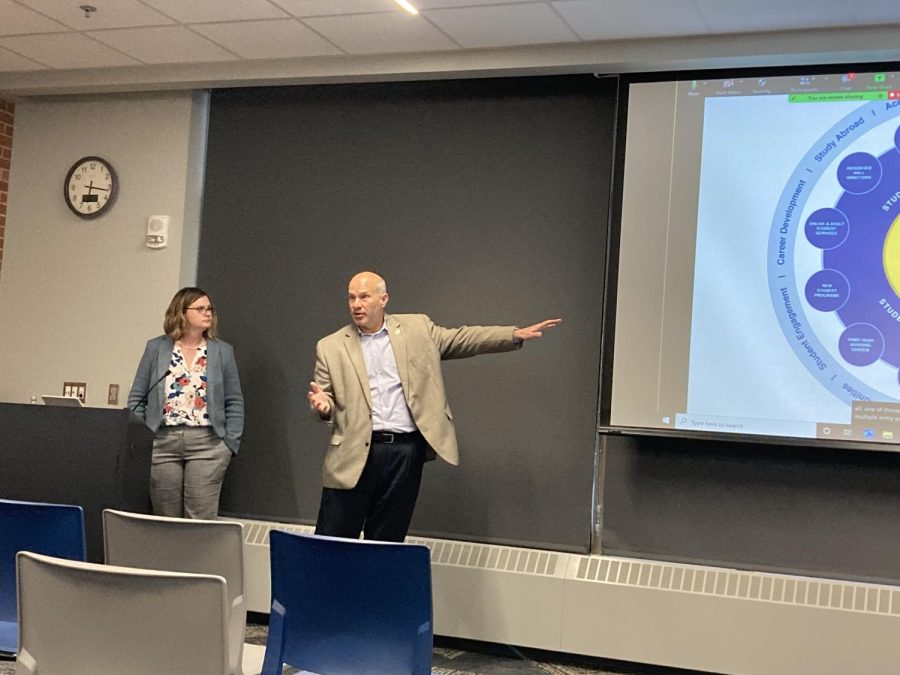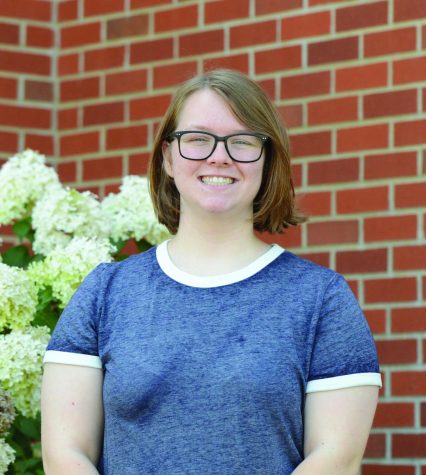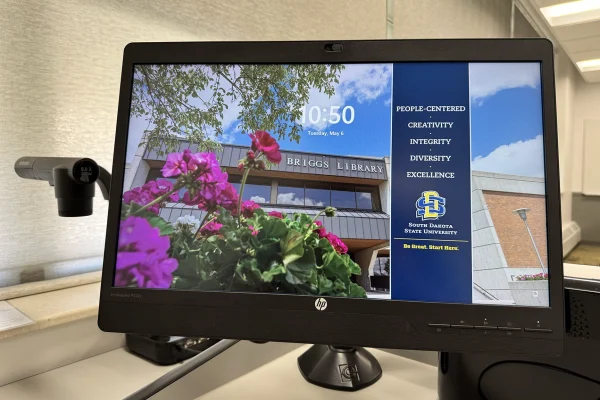New centers leave students, faculty out on a limb
Michaela Willis and Dennis Hedge present their current plans for SDSU’s opportunity center to students during the Oct. 26 listening session. This was the first of three sessions hosted by university officials to discuss opportunity centers.
October 26, 2021
When Gov. Kristi Noem’s letter asking the South Dakota Board of Regents to investigate for “agendas” in state universities was brought up during a meeting of South Dakota State University administrators and directors last May, former Director of the American Indian Student Center Erica Moore knew it was only the beginning.
“I called it out, I said, ‘this letter is going to produce damaging effects to our students,’” she said. “I said, ‘I will absolutely never be silent.’”
By August, the Board of Regents announced the Opportunity for All policy, outlining their plans for opportunity centers across the regental campuses, as well as plans to “proudly support the United States of America, safeguard the rich tradition of American universities and offer curriculum that is based upon widely held and accepted knowledge and thought.”
And by early October, Moore and three other staff members – American Indian Student Success Adviser Morgan Catlett-Ausborn, Coordinator of Multicultural Recruitment Gabriella Gillespie and Chief Diversity Officer Kas Williams – had decided to leave the university.
“That kind of set everything in motion for those of us who are working in diversity positions,” Moore said.
Now, students and faculty are still left with questions about what this change will mean and how it will impact marginalized groups on campus.
What We Know
The opportunity centers, set to be implemented by Jan. 1, 2022, are meant to be “one-stop shops” for all students, according to Nathan Lukkes, general counsel for SDBOR.
“Students from all walks of life can walk in the door and get connected with or access to the services, support, resources they need to address whatever issues or challenges they happen to be facing,” he said.
These centers will direct students to existing services on campus, like financial aid and tutoring. They may also perform some of the services related to retaining and graduating students that the diversity offices contained, though aimed at a less “niche market,” Lukkes said.
He also said that discussions about diversity on campuses have been a topic of debate for the Regents as far back as 2018.
Provost of Student Affairs Dennis Hedge and Vice President of Student Affairs Michaela Willis, who are working to plan SDSU’s opportunity centers, announced part of their plan for the centers so far during the Oct. 26 listening session held for students to give their feedback on the centers.
Their current plan is to house the center in the Wintrode Student Success Center, where it will help direct students to services like TRIO, the Wokini Initiative, first-year advising, disability services and more. There will also be a virtual aspect to the center.
“Our work that we have conducted was to really take a step back and evaluate all of the student success efforts that we currently have on campus,” Hedge said prior to the meeting. “What we landed upon was that we would really focus in on student success, which is in alignment with the Board of Regents’ guidance on this, but also really be reflective of our historic land-grant mission here at South Dakota State University.”
But with the emphasis on opportunity for “all,” these centers also come at the price of many universities’ diversity offices, like the Office of Diversity, Inclusion, Equity and Access at SDSU.
“There are a variety of things that are going to play out there,” Hedge said. “So right now, we do not have an Office of Diversity, Inclusion, Equity and Access.”
These decisions were primarily sparked by Noem’s desire that state universities “will resist the national trend teaching students that — by virtue of their sex, race, ethnicity, religion, color or national origin — they are inherently responsible for actions committed in the past by other members of those same classes,” according to her letter to the Regents.
She also instructed the Regents to ensure state universities were not promoting “action civics” like Critical Race Theory or the 1619 Project and that diversity offices were still working “in the scope of their original mission.”
According to Williams, the Office of Diversity’s role was to “fill in the gaps” at the university by promoting diversity and cultural training, offering community dialogues for students and faculty to participate in and working with university entities like Human Resources to examine institutional policies surrounding diversity and inclusion.
“We really look at the policies, and we’re looking at institutional change regarding diversity,” she said. “We’re looking at working with the community, and sometimes even statewide.”
Williams also worked with Housing and Residential Life to start and run Jacks’ Cupboard, a food pantry in Ben Reifel Hall available to students.
As of right now, there have not been many discussions about bringing back the diversity office or the programs it offered, according to Hedge and Willis.
The Uncertainties
One of the chief concerns from students and staff is how this change to opportunity centers will impact the programs and support offered by diversity offices.
Bailey Biegler, president of the Gender and Sexuality Alliance, said without Williams and the Office of Diversity, many of the projects in the works to improve resources for LGBTQ+ students will be hindered.
“We don’t have a retention adviser, and we have a really big issue with us getting lower classmen [involved in GSA],” she said. “So, (Kas) was that one trying to work on giving us more resources … but now that that’s gone, that’s not even a possibility anymore.”
The Latin American Student Association also lacks a retention adviser since the former adviser Florencio U. Aranda III left SDSU in December 2020.
Cierra Sazue, vice president of the American Indian Science and Engineering Society, said she is concerned about how opportunity centers will handle the number of students that may need assistance.
“Opportunity centers lack the individual attention that the diversity offices had,” she said. “I feel like it might be overwhelming for people who are going to run opportunity centers, because it’s just so many different people to work with and you can’t be educated on everyone’s background.”
Overall, most are unsure just what this will mean for the future of diversity at regental universities.
“It’s really difficult to know the depth of what this will do, because it took so long for institutions in South Dakota to even get on board with having a diversity office,” Moore said.
The Impacts
While the true impact of the opportunity centers won’t be realized until January, students and faculty are already feeling some of those effects.
“These opportunity centers aren’t benefiting us in any way, because even people in the Multicultural Center can’t use diversity, the word, in general,” Black Student Alliance President Ado Ghebrekidan said. “They think diversity is more exclusive, when diversity is supposed to be accepting.”
Williams said decisions like Noem’s and the Regent’s have stemmed from the political emphasis that discussions about diversity have taken recently.
“As a nation, people have talking points where they’re just kind of gaslighting conversations to get a certain outcome,” she said. “I tell folks all the time, I don’t play in politics … What I do is about service.”
Some students have also felt like their needs and questions aren’t being considered, Moore said, while giving an example of her own Indigenous students.
“They’re concerned, and they have questions, and they’re feeling like they’re not being answered,” Moore said. “And therefore, they feel like their opinions, their needs, aren’t valued.”
Sazue added that many people had chosen to leave SDSU in recent years because of similar changes made on campus.
“You’re pushing the smart people of color out,” she said. “Because of this, I’m thinking of going to graduate school somewhere else.”
Ghebrekidan said that the loss of the diversity offices and the programs they offered takes away from an already small pool of resources for minority students, staff and faculty.
“By implementing these opportunity centers, we’re basically taking these programs that have benefited us, and we’re basically … taking one of the only things that minorities have on this campus,” he said.
But Moore says the biggest loss is not the office itself, but the people and the support system that resided in it.
“At the end of the day, the diversity office is just an office,” she said. “It’s the people that were in that office that did that work for the students.”
Looking Ahead
Willis and Hedge urged students to attend future sessions to offer their feedback, as suggestions would be considered during the planning process. Willis added, though, that there are limitations to what changes they can make depending on how they align with the board’s original charge.
Still, Hedge said he considers the feedback from sessions to be “incredibly valuable.”
“I encourage everyone to come out and share their thoughts and opinions with us,” he said.
Two more university-wide sessions will be held later on that also are available for students to attend. One will be from 8:30-9:30 a.m., Friday, Oct. 29 in the Dakota A&C Room, and the other will be from 3:30-4:30 p.m., Tuesday, Nov. 2 in the Pheasant/Crest Room.
Some students like Alexis Martin, a member of AISES and the American Indian Student Association, want the Regents to engage more with the students they serve and their backgrounds.
“I think the Board of Regents needs to educate themselves more, it’s not just like, ‘oh, this is what happened to Native Americans and … people of color,’” she said. “Actually come and experience it, see all the different people on campus.”
Ghebrekidan added that he wishes for more diversity and representation on the board itself.
“There’s no minorities on that South Dakota Board of Regents panel,” he said, “and so how can you represent me properly if I don’t have somebody that can properly represent me?”
While some are hesitant about the changes the Regents are making, Williams is remaining optimistic.
“I think change is always progress, regardless of how it happens or what happens,” she said. “I’m hoping that people will become more aware of what the diversity offices are … so they can really see the work that we do.”
Still, not everyone shares her hopefulness.
“This was [Noem’s] first ask, and we conceded,” Moore said. “So, what will they continue to ask for, and what will we continue to give or take?”
























Adam G • Oct 29, 2021 at 11:23 am
When the Governor’s Office released a statement saying: “I am glad to see that so-called diversity offices, which have unfortunately become less about serving students and more about advancing leftist agendas, are being replaced by Opportunity Centers that will focus on students as individuals, rather than members of groups,” it is hard to not see this as an attempt to defund or reallocate staff and funding away from marginalized students that are already being recruited, retained, and supported in smaller numbers and lesser ways than white, heterosexual, and cisgendered students. In order for SDSU students to be successful they need to recognize the ways the Governor and Board of Regents are limiting the global and diversity centered work force that companies and employers are seeking in 2021.